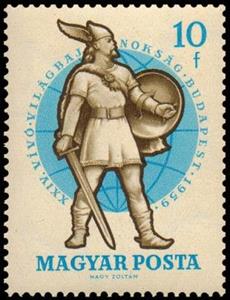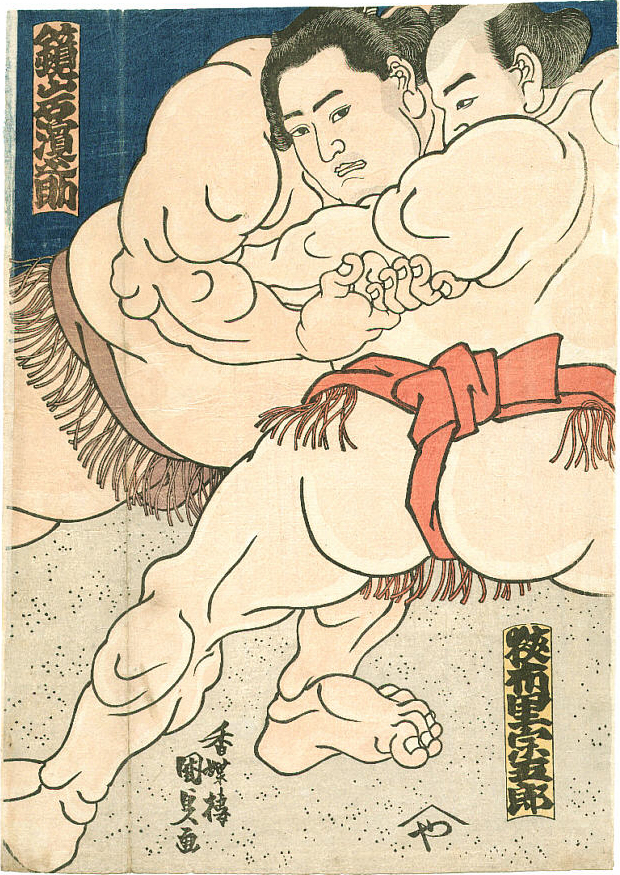Stamp: Combatant of the 10th Cty. (Hungary 1959)
Combatant of the 10th Cty. (Hungary 1959)
11 July (Hungary ) within release World Fencing Championships, Budapest goes into circulation Stamp Combatant of the 10th Cty. face value 10 Hungarian fillér
| Stamp Combatant of the 10th Cty. in catalogues | |
|---|---|
| Michel: | Mi:HU 1601A |
| Stamp Number: | Sn:HU 1241 |
Stamp is vertical format.
Also in the issue World Fencing Championships, Budapest:
- Stamp - Combatant of the 10th Cty. face value 10;
- Stamp - Combatant of the 15th Cty. face value 20;
- Stamp - Combatant of the 19th Cty. face value 30;
- Stamp - Combatant of the 19th Cty. face value 40;
- Stamp - Mounted Combatant of the 19th Cty. face value 60;
- Stamp - Fencer Charging face value 1;
- Stamp - Fencer in Basic Position face value 1.40;
- Stamp - Fencer Greeting face value 3;
- Stamp - Fighter from the 10th century face value 10;
- Stamp - Combatant of the 10th Cty. face value 10;
- Stamp - Combatant of the 15th Cty. face value 20;
- Stamp - Combatant of the 19th Cty. face value 30;
- Stamp - Combatant of the 19th Cty. face value 40;
- Stamp - Fencer Charging face value 1;
- Stamp - Fencer Greeting face value 3;
- Stamp - Fencer in Basic Position face value 1.40;
- Stamp - Mounted Combatant of the 19th Cty. face value 60;
- Stamp - Combatant of the 10th Century face value 10;
- Stamp - Combatant of the 15th Century face value 20;
- Stamp - Combatant of the 19th Century face value 30;
- Stamp - Combatant of the 19th Century face value 40;
- Stamp - Fencer in Basic Position face value 1.40;
- Stamp - Mounted Combatant of the 19th Century face value 60;
Stamp Combatant of the 10th Cty. it reflects the thematic directions:
Sports, are all usually forms of competitive physical activity or games which, through casual or organised participation, aim to use, maintain or improve physical ability and skills while providing enjoyment to participants, and in some cases, entertainment for spectators. Usually the contest or game is between two sides, each attempting to exceed the other. Some sports allow a tie game; others provide tie-breaking methods, to ensure one winner and one loser. A number of such two-sided contests may be arranged in a tournament producing a champion. Many sports leagues make an annual champion by arranging games in a regular sports season, followed in some cases by playoffs. Hundreds of sports exist, from those between single contestants, through to those with hundreds of simultaneous participants, either in teams or competing as individuals. In certain sports such as racing, many contestants may compete, each against each other, with one winner.
A military, also known collectively as an armed forces, are a heavily armed, highly organized force primarily intended for warfare. Militaries are typically authorized and maintained by a sovereign state, with their members identifiable by a distinct military uniform. They may consist of one or more military branches such as an army, navy, air force, space force, marines, or coast guard. The main task of a military is usually defined as defence of their state and its interests against external armed threats.
Martial arts are codified systems and traditions of combat practiced for a number of reasons such as self-defence; military and law enforcement applications; competition; physical, mental, and spiritual development; entertainment; and the preservation of a nation's intangible cultural heritage
An army, ground force or land force is an armed force that fights primarily on land. In the broadest sense, it is the land-based military branch, service branch or armed service of a nation or country. It may also include aviation assets by possessing an army aviation component. Within a national military force, the word army may also mean a field army.
Fencing is a combat sport that features sword fighting. It consists of three primary disciplines: foil, épée, and sabre (also spelled saber), each with its own blade and set of rules. Most competitive fencers specialise in one of these disciplines. The modern sport gained prominence near the end of the 19th century, evolving from historical European swordsmanship. The Italian school altered the historical European martial art of classical fencing, and the French school later refined that system. Scoring points in a fencing competition is done by making contact with the opponent with one's sword.
A sword is an edged, bladed weapon intended for manual cutting or thrusting. Its blade, longer than a knife or dagger, is attached to a hilt and can be straight or curved. A thrusting sword tends to have a straighter blade with a pointed tip. A slashing sword is more likely to be curved and to have a sharpened cutting edge on one or both sides of the blade. Many swords are designed for both thrusting and slashing. The precise definition of a sword varies by historical epoch and geographic region.





